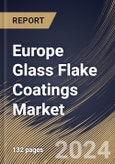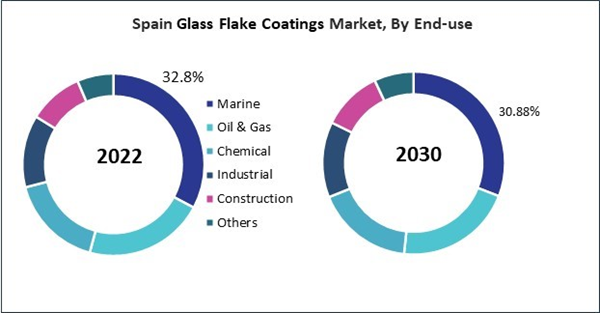Epoxy-based coatings fortified with glass flakes offer a formidable combination of strength, corrosion resistance, and aesthetic appeal, making them ideal for a wide range of applications across various industries. The incorporation of glass flakes enhances the mechanical strength of epoxy coatings, providing additional reinforcement against impacts, abrasion, and chemical exposure. Therefore, the Germany market make use of 111.58 hundred tonnes of glass flake coatings by epoxy in 2022.
The Germany market dominated the Europe Glass Flake Coatings Market by Country in 2022, and would continue to be a dominant market till 2030; thereby, achieving a market value of $126.9 Million by 2030. The UK market is exhibiting a CAGR of 2.7% during (2023 - 2030). Additionally, The France market would experience a CAGR of 4.5% during (2023 - 2030).
One of the primary drivers of the adoption of glass flake coatings is their unparalleled corrosion resistance. Industries such as marine, oil and gas, and chemical processing, where corrosion significantly threatens infrastructure and equipment, have increasingly turned to glass flake coatings. The ability of these coatings to form a resilient barrier against corrosive elements enhances the durability of assets, leading to longer lifespans and reduced maintenance costs.
Additionally, the versatility of glass flake coatings is a key factor contributing to their adoption across various industries. From maritime applications to automotive, infrastructure, and beyond, these coatings address the unique challenges of different environments. The adaptability of glass flake coatings to various substrates and conditions enhances their appeal and widens their scope of application, fostering increased adoption.
In 2022, the U.K. Government planned to invest over 160 million dollars to improve infrastructure and aid local communities. This expenditure mainly focuses on developing and repairing four major road schemes: the road linking St Austell to the A30, Tyne Bridge, A34, and A35 Redbridge Causeway. Thus, all these factors will uplift the regional market’s expansion in the coming years.
Based on Material, the market is segmented into Epoxy, Vinyl Ester, and Polyester. Based on End Use, the market is segmented into Marine, Oil & Gas, Chemical, Industrial, Construction, and Others. Based on countries, the market is segmented into Germany, UK, France, Russia, Spain, Italy, and Rest of Europe.
List of Key Companies Profiled
- Akzo Nobel N.V.
- Hempel A/S
- PPG Industries, Inc.
- KCC Corporation (Momentive Performance Materials Inc.,)
- Kansai Paint Co., Ltd.
- Berger Paints India Limited
- The Sherwin-Williams Company
- Jotun A/S
- Deccan Mechanical & Chemical Industries Pvt. Ltd
- Chugoku Marine Paints, Ltd.
Market Report Segmentation
By Material (Volume, Hundred Tonnes, USD Billion, 2019-2030)- Epoxy
- Vinyl Ester
- Polyester
- Marine
- Oil & Gas
- Chemical
- Industrial
- Construction
- Others
- Germany
- UK
- France
- Russia
- Spain
- Italy
- Rest of Europe
Table of Contents
Companies Mentioned
- Akzo Nobel N.V.
- Hempel A/S
- PPG Industries, Inc.
- KCC Corporation (Momentive Performance Materials Inc.,)
- Kansai Paint Co., Ltd.
- Berger Paints India Limited
- The Sherwin-Williams Company
- Jotun A/S
- Deccan Mechanical & Chemical Industries Pvt. Ltd
- Chugoku Marine Paints, Ltd.









